5 Amazon SES alternatives, recommended by... an Amazon SES competitor?!
Using Amazon for email is like going to a car dealership and buying a car for 200 bucks. No other provider can match that kind of price—but there’s a catch: they give you all the individual parts, and you’ve got to put the car together yourself.
So if you don’t have a whole team to dedicate to it, are dealing with limited resources, or need to move fast, you might need to look at alternative car dealerships. And the same is true for email delivery services 😉
Here is a list of alternative providers to Amazon Simple Email Service (SES)... compiled by us, an Amazon SES alternative provider! Postmark is the only email delivery service we know inside out, so it’s also the only one we can wholeheartedly endorse. But we also know from talking to thousands of customers over the last 13 years that we are not for everybody, so we recommend that you carefully check out all the other alternatives listed below.
Your 5 Amazon SES alternatives for 2025 #
Here is a handy spreadsheet that helps you compare Amazon SES and its main alternatives and competitors on data points like pricing, documentation, and customer support.
[Methodology: we compiled this list by asking one question to Postmark’s Heads of Product, Deliverability, and Customer Success: ’Based on what YOU know about our customers, who they switch to and from, and the state of the market/industry, which providers would you name as valid Amazon SES alternatives?’ We trust these folks to have the most deeply-researched, best-documented, and up-to-date answers.]
1. Postmark (hi 👋)
#

At Postmark, we launched our email delivery service back in 2009, and up until 2020 we focused on transactional email only, building a loyal following of customers who call us rock solid, nothing but amazing, and the best choice ever.
Since 2020, we expanded our sending infrastructure to allow Postmark’s customers to send promotional and marketing emails as well (both via SMTP and API). Unlike everybody else on this page, we keep the marketing and transactional streams completely separate from one another, so the quality of our delivery for both transactional and bulk remains top-notch… unlike that of other providers, which often experience serious deliverability issues and occasionally even charge you to solve them (not cool).
👍 Pros #
Lightning-fast and reliable email delivery: Our entire business revolves around never losing a single email and ensuring that your transactional messages arrive quickly, not eventually. Speed is at the core of our work, and we are the only provider that shares delivery times publicly.

- Promotional and transactional emails don’t mix: our Message Streams feature helps you separate marketing and transactional emails, which helps protect the high deliverability of your business-critical transactional messages.
- 45 days of data retention by default: each Stream’s activity feed gives you full access to the data you need including delivery events, bounces, opens, and clicks for 45 days—and you can customize the data retention period from 7 to 365 days.
- Transparent pricing: we use volume-based pricing, which means that how much you pay only depends on the number of emails you send.
- Stellar customer service at no extra charge: we don’t have an extra premium charge for customer support. Our top-notch customer team is always available via email, chat, and phone, and their satisfaction ratings are consistently over 95%.
- Email templates: if you’re looking to start sending transactional emails fast, you can just pick our content-ready, responsive email templates and layouts. They can help you send the most common transactional messages a business might need (such as welcome emails, password resets, user invites, invoices, and receipts), and will look great in all major email clients.
- Excellent documentation: technical teams know that great documentation makes all the difference between a smooth implementation and a giant headache. With Postmark, you’re in safe hands: our customers often rave about our user-friendly, easy-to-understand docs that help them get set up quickly. You can check them out for yourself by following this link!
- We do NOT try to upsell you on dedicated IP addresses you don’t need. One of our biggest email pet peeves is email delivery services that insist dedicated IPs are the only way to achieve great deliverability. They are not.
👎 Cons #
- Narrow focus: our primary focus has been and remains email delivery, so we aren’t an “everything service” like some of the alternatives on this list. For example, we don’t offer SMS services or list management/ email marketing automation features out of the box. But we do integrate nicely with a lot of tools and services that do.
Postmark pricing #
Our straightforward pricing is based solely on volume—i.e. the number of emails your application sends and receives per month. Here’s a pricing snapshot:
- Want to send 10,000 emails? $15/month
- Want to send 300,000 emails? $245/month
- Want to send 1 million emails? $695/month
💛 Friendly tip: a lot of services that look cheap on paper (for example, Amazon SES itself) turn out to be very expensive when you add on overages or premium support. We said it above, but it’s worth repeating that Postmark is the only provider on this page that won’t charge extra for premium support. Our excellent email, chat, and phone support are already included in all plans.
One final thing... #
We think you might feel safer knowing there are real humans behind Postmark you can get in touch with, so here we are: a fully remote team spread across the USA, Europe, Africa, and Asia, who meets in person ~once a year, and likes to (poorly) Photoshop those who can’t join us into our group photos:

2. SendGrid
#
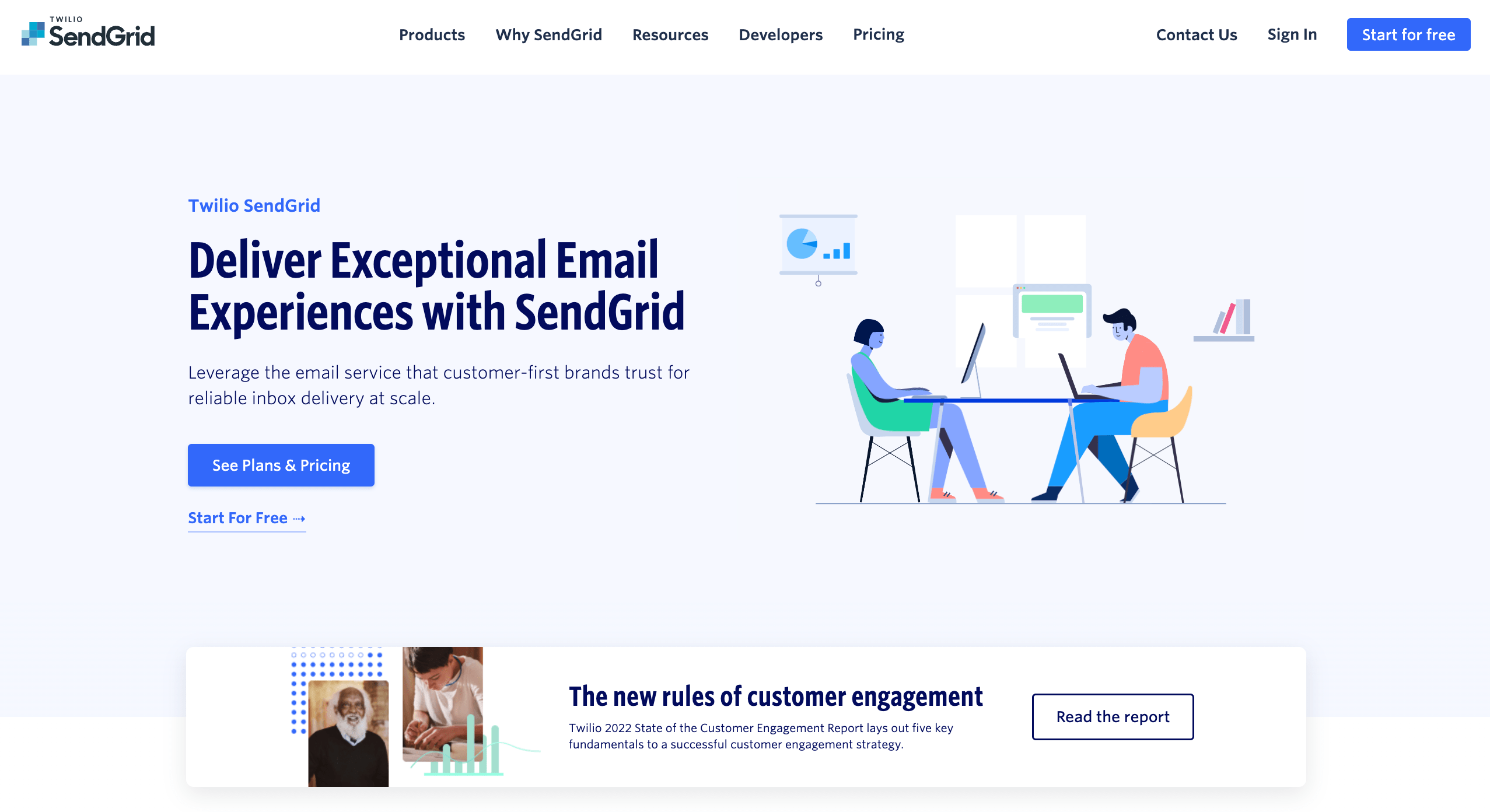
SendGrid has been in the email industry for more than a decade, much like us. Though it began as a basic email API in 2009, it has since developed into a comprehensive email platform that offers a diverse range of services with email design, testing, and marketing tools. Following its acquisition by Twilio in 2019, SendGrid’s tools now include SMS and WhatsApp, so existing and new customers benefit from an expanded range of features.
👍 Pros #
Established industry player: SendGrid is one of the oldest and largest email service providers out there (in 2022 alone, according to their homepage stats, they processed 134+ billion emails per month. That’s a lot of emails!).
A powerful all-in-one service: Customers in need of an all-in-one service with customer engagement tools, marketing automation, and transactional email will find SendGrid to be a valid choice—especially after its recent integration with parent company Twilio.
👎 Cons #
Deliverability is mixed: SendGrid’s users occasionally experience issues with its IPs’ deliverability, leading to mixed results for quality, reliability, and speed.
Pay more for better service: Customers who face deliverability issues are usually advised to upgrade to higher-priced packages with a dedicated IP (we think that’s not troubleshooting or customer service—it’s upselling).
Choose your support level—“slow” or “expensive”: Since the 2019 Twilio acquisition, some customers have expressed dissatisfaction with their customer support experiences. Premium support is an option, but (unlike at Postmark) it comes at an additional cost.
SendGrid pricing #
SendGrid presents four different plans with varying feature sets, send volumes, and customer support levels. Below, we’re showing pricing for the most affordable plan per email volume—but here’s a tip: make sure to read the fine print and pick the plan that includes the features you need.
What does it cost to send 10,000 emails? $19.95/month (Essentials plan)
What does it cost to send 300,000 emails? $249/month (Pro 300k plan)
What does it cost to send 1 million emails? $602/month (Pro 700k plan + overages)
3. Mailchimp Transactional
#
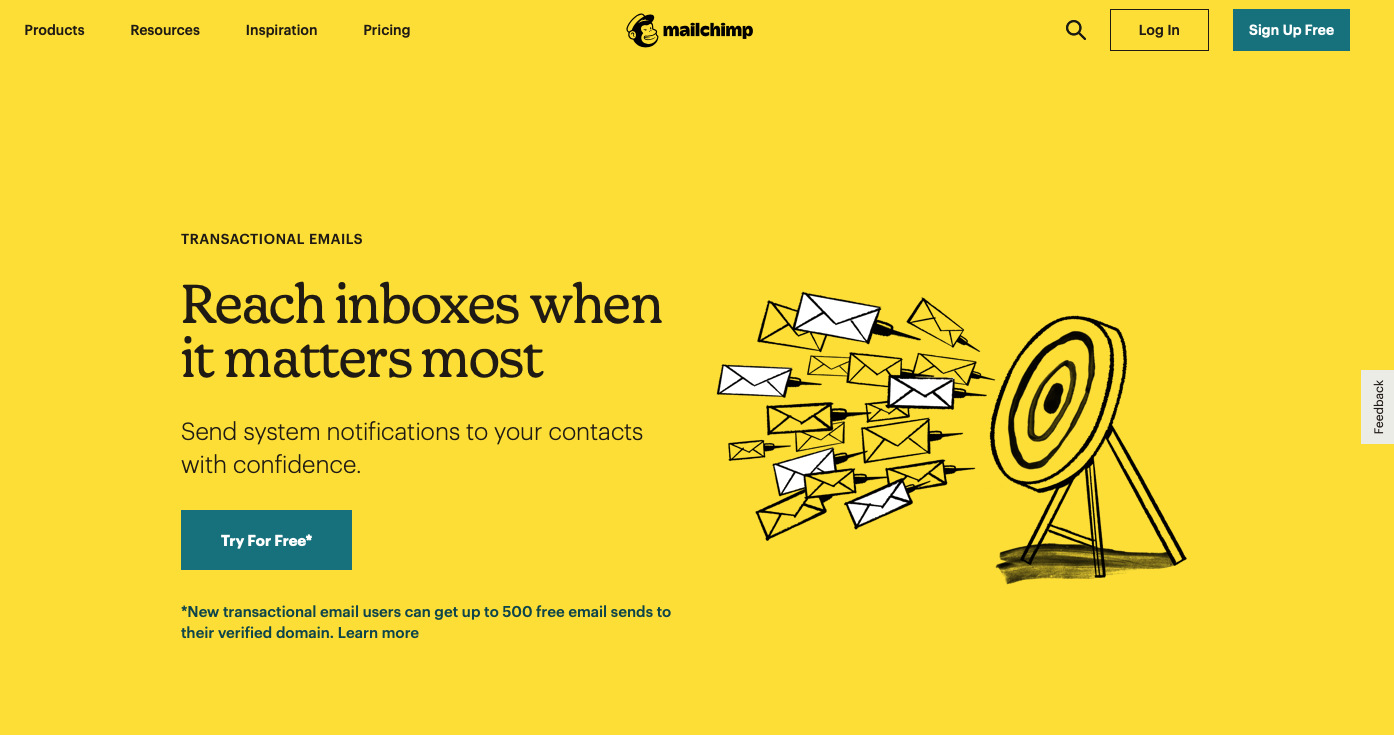
Mailchimp Transactional might be a good SES alternative for your transactional emails if you are either A) an existing Mailchimp customer or B) planning on becoming one. That’s because Mandrill used to be a standalone service, but it now only exists as a paid add-on for existing Mailchimp users.
(Sidenote: if you make your email delivery service decisions based on color palettes, we think it’s important to tell you that Mandrill and Mailchimp are yellow, but we were yellow first.)
👍 Pros #
One-stop shop: the Mailchimp plus Mandrill combo gives you a well-integrated package if you need it all—email, marketing, automations.
Strong analytics: Mailchimp offers robust analytics that include customizable options, pre-built dashboards, and an export API.
👎 Cons #
Lack of product focus: Mailchimp’s main focus is likely on email marketing automation. Being an add-on, Mandrill might not be getting the same amount of love.
Cost: Both Mailchimp and Mandrill are on the expensive side (especially if you compare them to Amazon SES). And yes: you’ll have to pay for both.
Mandrill pricing #
Bulk emails are sold in blocks of 25k emails, and the cost per block varies depending on the total monthly email volume you want to buy. This cost is in addition to a Mailchimp monthly plan, so make sure to combine the two for the most accurate picture of your email sending costs:
- Send 10,000 emails? $20 (+the price of your regular Mailchimp subscription)
- Send 300,000 emails? $240 (+the price of your regular Mailchimp subscription)
- Send 1 million emails? $720 (+the price of your regular Mailchimp subscription)
4. Mailgun #
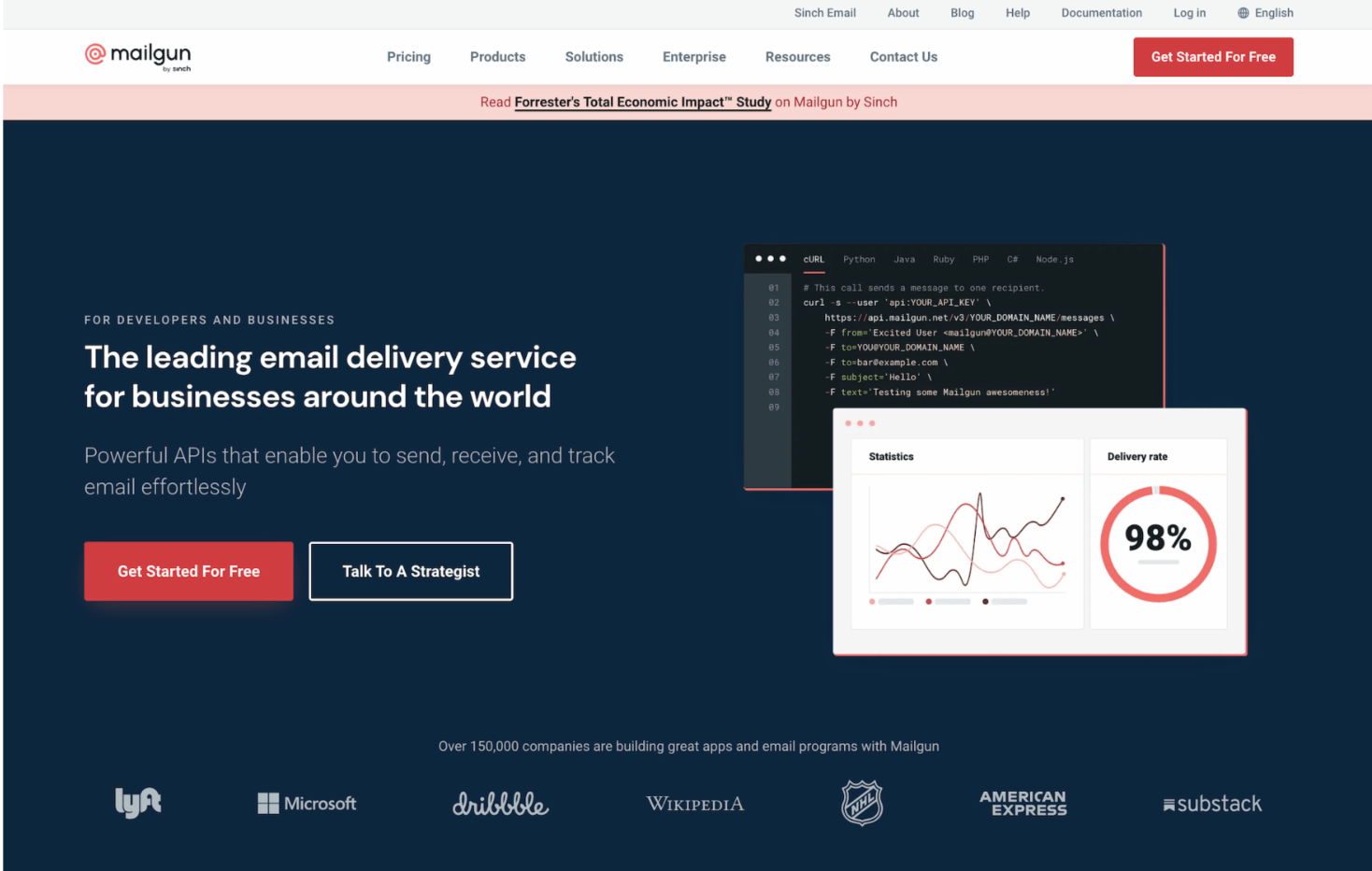
Developer and technical teams who need an Amazon SES alternative often opt for Mailgun because of its versatile email API, comprehensive documentation, and integration options.
In 2021, the Mailgun team underwent a series of acquisitions, first by Pathwire and later by Sinch. This double acquisition is not unusual (Postmark was also acquired by ActiveCampaign in 2022), but Mailgun remains a standalone product while being part of a more extensive ecosystem of services that includes email verification, testing, and deliverability tools. These tools are offered separately and come at an additional cost.
👍 Pros #
99.99% uptime SLA
Scalable plans: Mailgun’s pay-as-you-go pricing comes in handy while you’re still figuring out how many emails you need to send.
👎 Cons #
Mixed customer support reviews: reviews skew heavily toward either “excellent” or “poor” on Trustpilot (where the Mailgun team seems to be active and replying frequently, which is a point in their favor).
Inconsistent deliverability and sending speed: this may not be a common problem, but some customers (including folks who have since switched from Mailgun to Postmark) have reported deliverability issues with their emails not reaching the desired inbox promptly.
Mailgun pricing #
Mailgun has four pricing and service tiers available. Like with everyone else on this list, review each plan’s description carefully to make sure you’re getting every feature you need, including the relevant support level (for example: chat support is only available on Scale plans and above, while phone support is limited to Enterprise customers).
- Send 10,000 emails? $35 (Foundation plan)
- Send 300,000 emails? $255/month (Scale plan 250K emails + overages)
- Send 1 million emails? $700/month (Scale plan 1 million emails)
5. MessageBird Email (formerly SparkPost)
#
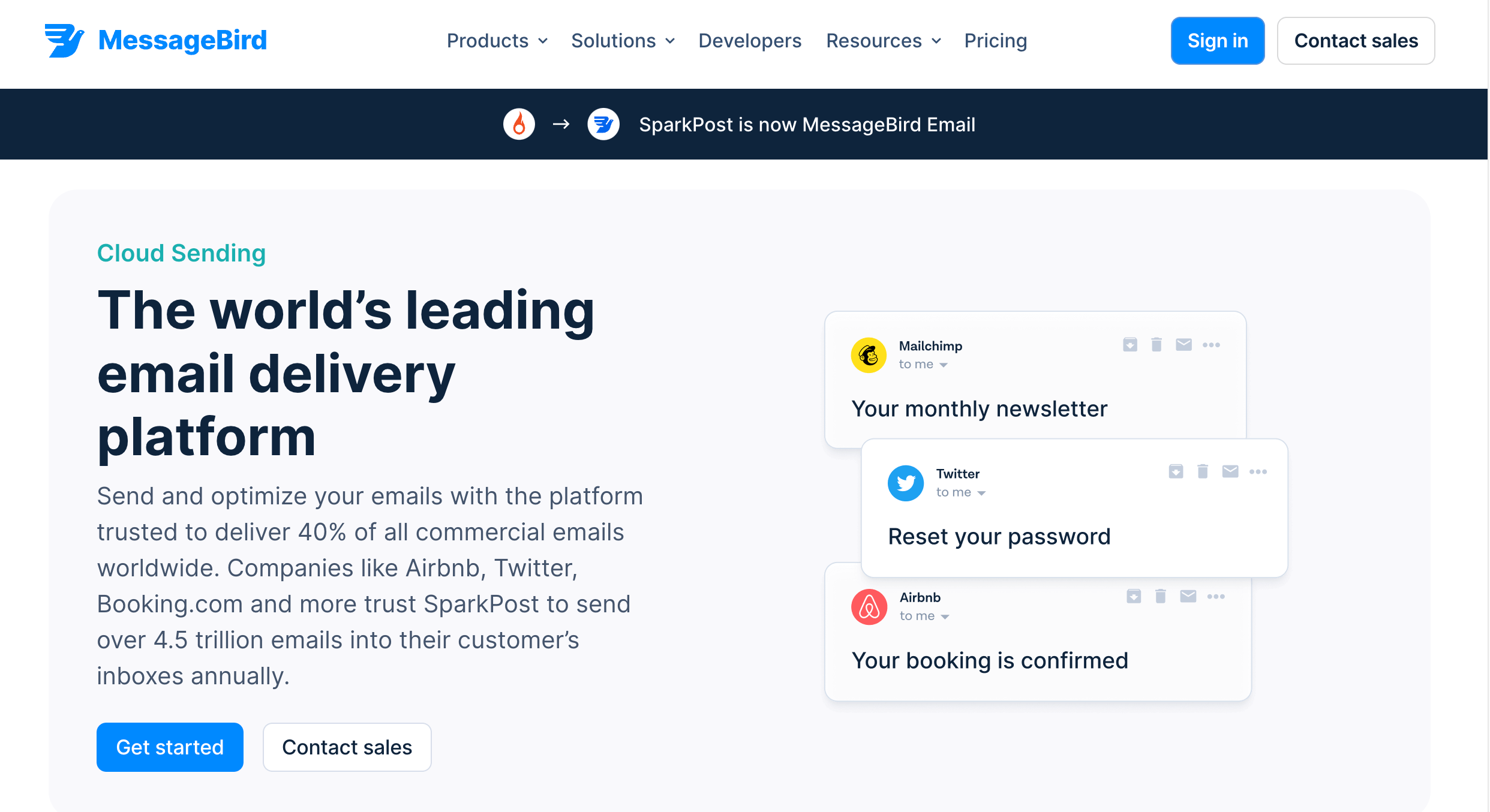
The brand formerly known as SparkPost, MessageBird Email, claims to deliver 40% of all commercial emails worldwide, with over 4.5 trillion annual sends. This number is far too large for us to comprehend or compare ourselves to, so we’ll just come out and say it: it sounds like an impressive amount of emails!
With enterprise-level analytics, competitive intelligence features, and a focus on high-volume commercial sending, MessageBird goes well beyond email delivery—in that sense, it’s kind of similar to SendGrid, which we covered above. If you run an enterprise business and/or work in a highly regulated industry, it’s likely to be a solid partner for your needs.
👍 Pros #
99.99% uptime guaranteed by SLA.
Detailed developer docs: the comprehensive documentation help users and customers navigate MessageBird’s complex features.
Compliance and enterprise support: businesses in industries with specific security and compliance regulations (e.g. finance or health) will find what they need in MessageBird—but what’s a pro for one company is a con for another. Speaking of which:
👎 Cons #
Enterprise focus: since MessageBird is focused on offering everything a large business could need, its complexity could be too much for medium-sized companies or startups.
MessageBird pricing #
MessageBird offers three service levels (Starter, Premier, and customized Enterprise plans) with different features, each covering different email volume levels.
Here’s what MessageBird will charge for sending your emails:
- What does it cost to send 10,000 emails? $20/month (Starter)
- What does it cost to send 300,000 emails? $205/month (Premier plan + overage fees)
- What does it cost to send 1M emails? $525/month (Premier)
We made it to the end, friends!
Here is the comparison spreadsheet once again: if you need to see it, just click on it ↓
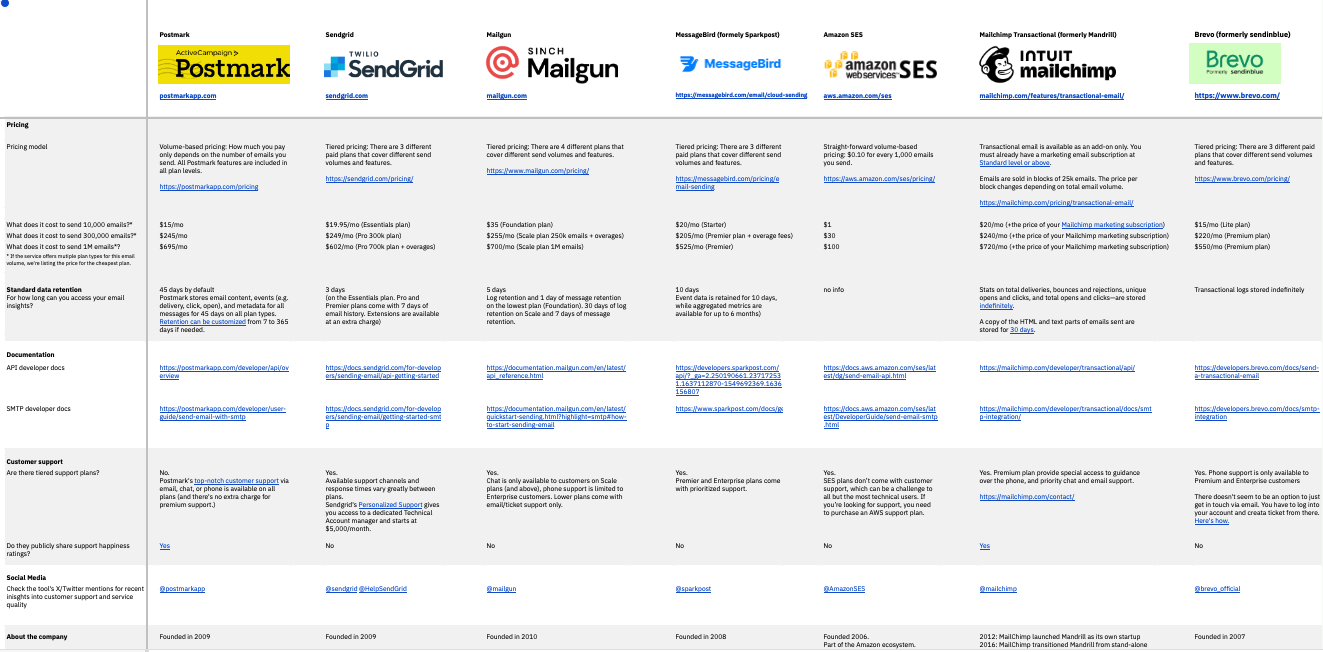
Why don't you to give this Amazon SES alternative a try?
Join thousands of businesses that already trust their email delivery to Postmark.


